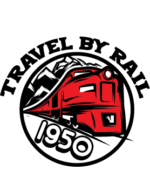Introduction
Americans depended on the railroads for travel from city to city and state to state for one hundred years, from the 1850’s until the 1950’s. In the 1800’s, trains were a faster and more comfortable alternate to riding horseback or by stagecoach. In the early 1900’s, cars and airplanes were invented, but until the 1950’s long distance car travel took a long time, as the highways passed right down Main Street, through the center of every town and city along the way. And air travel was much too expensive for most Americans. Even owning a car was too expensive for many families – it was not until the year 1950 that more than half the families in the USA owned a car. So trains were the preferred way to travel.
Between 1950 and 1960 everything changed: More and more families bought cars. President Eisenhower proposed a nationwide network of high speed Interstate Highways, and construction began in 1956. Now Main Street and all the stoplights could be bypassed. The first successful jet airliner, the Boeing 707, went into service in 1958. Compared to propeller planes, it was almost twice as fast, and could travel farther non-stop. With travel by car and plane becoming more popular, the trains had fewer and fewer passengers, and by 1960 most railroads were running fewer trains.
The number of passenger trains continued to decline all through the 1960’s. The final straw for many passenger trains was the loss of their contracts with the US Post Office to carry the mail. The Post Office had switched to the airlines, just like most travelers. To keep passenger trains from completely disappearing, Congress created Amtrak, which took over operation of Intercity trains from the railroads in 1971. Amtrak has kept a nationwide network of trains in operation for the past 50 years, but their trains serve only a small fraction of the cities that had service back in 1950.
This website will take you back in time – before Amtrak, before jet airliners, before Interstate Highways. You can trace the routes of passenger trains through your own state on maps that show railroad lines instead of highways. You can select any city shown on the maps and read the schedules of trains that ran to and from that city in 1950. The schedules list over 750 daily trains, serving over 1000 cities and many small towns. First, go to the toolbar and click on ABOUT THE SCHEDULES to learn how to read the schedules. Then, click on MAPS & CITY SCHEDULES to view the maps and find out where the trains could take you – in 1950.
